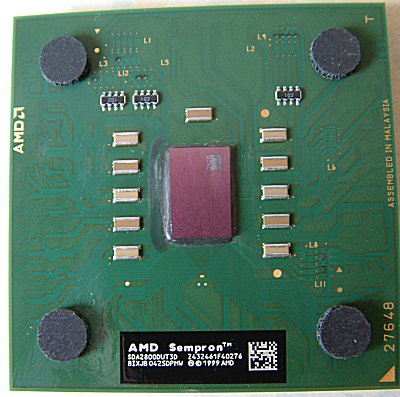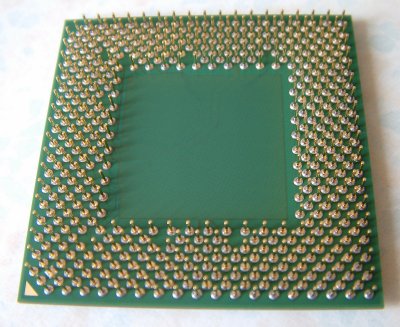AMD Sempron 2800+
The nomenclature Sempron applies to both Socket A and Socket 754, as well as mobile parts, and that's where distinguishing between processors becomes difficult. AMD's decided that Sempron processors should have their roots in Socket A (462-pin), with 6 models that range from the Sempron 2200+ through to Sempron 2800+. Let's take a closer visual look.
Socket A Semprons, represented by the 2800+ model here, are nothing more than rebranded Athlon XPs that run with a Thoroughbred B core and with a native 166MHz Front-Side Bus. Using 256KB of exclusive L2 on-chip cache, they're intrinsically cheaper than the 512KB-equipped Bartons to manufacture. That's how AMD's playing it, that is, focussing purely on value with a proven K7 core that has served it well over the past couple of years.

Our sample Sempron 2800+ fits into the wide, inexpensive range of Socket A boards that are currently available from almost every manufacturer. Decent, big-name boards can be had for as little as £30, which again reinforces the value aspect of AMD's Socket A Sempron line.
All Socket A Semprons, therefore, are only distinguished with respect to speed. In terms of specification, they share the following characteristics:
Socket 462/Socket A form factor
166MHz Front-Side Bus (double-pumped to 333MHz)
130nm manufacturing process
128KB L1 cache, 256KB L2 cache
~38m transistor count
| Model name | Clock speed | Price (approximate) |
| Sempron 2200+ | 1.5GHz | £35 |
| Sempron 2300+ | 1.57GHz | £40 |
| Sempron 2400+ | 1.667GHz | £45 |
| Sempron 2500+ | 1.75GHz | £50 |
| Sempron 2600+ | 1.83GHz | £60 |
| Sempron 2800+ | 2.0GHz | £75 |
You pays your money and makes your choice. AMD's given highest-rated Socket A Sempron an extra nudge on the ratings' count. It's interesting to note AMD's constant jigging of actual processor speed and model numbering. Those with long memories may remember the short-lived Athlon XP2800+, a Thoroughbred-based processor that ran at 2.25GHz with a 166MHz FSB. Now 2GHz buys you exactly the same rating. Further, the Barton XP2800+, running with double the Sempron 2800+'s 256kb L2 cache, was clocked in at 2.083GHz. There's been little internal consistently from AMD. Rather, it seems that its numbering scheme has always tried to approximate the MHz rating from its erstwhile competitor's CPUs.









